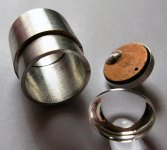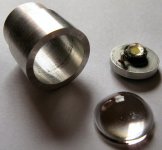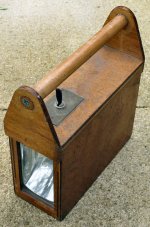Strangely enough, according to diodes inc's own calculator the efficiency falls slightly when hooked up to a PFC....
This makes sense as the power factor correction circuit will draw current to function. The power consumed by the entire circuit will go up, but the power dissipated in the wires will go down.
Great discussion folks! I won't pretend to understand everything written here but it has still enabled me to better understand LED lighting systems. Sorry to take so long to respond - a few weeks ago I had to delete Firefox and all of its various folders including all of my bookmarks  due to a weird, pdf-based(!!) piece of malware.
due to a weird, pdf-based(!!) piece of malware.
Anyhoo.......
One aspect of LED lighting that is also interesting to me is the various lens/light dispersion system (not sure if that's the correct term) that each manufacturer uses. Some of these involve lenses with interesting shapes placed on top of the LEDs themselves, like this one:
amazon.com/Feit-Electric-CFC-LED-Performance/dp/B003YL3DXI
......while others use outer "bulbs" that go from conventional to really "out there", like a house brand 40 watt equivalent bulb sold at Home Depot I saw recently (looked but couldn't find it on their website) that used a frosted outer envelope that looks like one of the flying saucers seen in a 1950's sci-fi movie. And of course Philips' funky lamp with its squashed yellow bulb:
yellow bulb:
inhabitat.com/philips-unveils-worlds-first-led-replacement-for-most-common-bulb/
Anyhoo.......
One aspect of LED lighting that is also interesting to me is the various lens/light dispersion system (not sure if that's the correct term) that each manufacturer uses. Some of these involve lenses with interesting shapes placed on top of the LEDs themselves, like this one:
amazon.com/Feit-Electric-CFC-LED-Performance/dp/B003YL3DXI
......while others use outer "bulbs" that go from conventional to really "out there", like a house brand 40 watt equivalent bulb sold at Home Depot I saw recently (looked but couldn't find it on their website) that used a frosted outer envelope that looks like one of the flying saucers seen in a 1950's sci-fi movie. And of course Philips' funky lamp with its squashed
inhabitat.com/philips-unveils-worlds-first-led-replacement-for-most-common-bulb/
Last edited:
I'm getting close to blowing the $15 on that Feit lamp above, simply to see how well that lens disperses the LED's light even though I have no (practical) use for that type of lamp right now.It is an art in its own.....
3W led bulb, not wort it, buy some candles.
I see Philips is bringing out a decent retrofit, though about double the price you were looking at. It uses 17W to put out 1100 lumen wich is just a bit south of a 100W incandecent.
Philips Announces the World's First LED Replacement for the 75-Watt Bulb | Inhabitat - Green Design Will Save the World
I have bad news for Philips though we are in production for a more efficient retrofit at probably half the price, and uber sexy and futuristic. I can't wait till I can share.
I see Philips is bringing out a decent retrofit, though about double the price you were looking at. It uses 17W to put out 1100 lumen wich is just a bit south of a 100W incandecent.
Philips Announces the World's First LED Replacement for the 75-Watt Bulb | Inhabitat - Green Design Will Save the World
I have bad news for Philips though we are in production for a more efficient retrofit at probably half the price, and uber sexy and futuristic. I can't wait till I can share.
So do you work for one of the big 3 LED companies (Cree, OSRAM, Philips (obviously not philips)? or one of slightly smaller ones like SSC? Or you can't say. If not I understand as there is a lot about my quantum dot stuff I can't talk about. I can show the pretty pictures and all of that but when it comes to how I make them/reagents used/etc. the NDA comes into play.
3W led bulb, not wort it, buy some candles.
Oh, I don't know, 3W makes not a bad flashlight.
Some bits I made a couple of years ago for an experimental aspheric lens flashlight with Seoul Semi LEDs:-


I've been into portable lighting for a while. Here's a lantern I built about 20 years ago. It uses NiCads and a 55W Auto bulb and reflector. With the plain glass it's about as tight a beam you can get short of a laser. There's a second 5W bulb offcentre for spread light. A wall wart inside is used for charging. Still going strong on the original 12 4AH batteries. It's waterproof, chuck it in and it floats handle up. Eventually it'll become worthwhile to build an LED replacement.

I used to spend some time on candlepowerforums, but I got p*ssed off listening to guys who had just spent $300 on a flashlight.
w
Nice.I am part of a small upstart with support from Cree.
These are only related to this thread because they are totally the polar opposites of what the thread is about (plus they aren't that earth shaking to warrant their own thread). Yesterday I saw these "vintage" incandescent bulbs and while I think they're overpriced, I'm still trying to think of a good reason to buy one of each  :
:
homedepot.com/h_d1/N-5yc1v/R-202245668/h_d2/ProductDisplay?langId=-1&storeId=10051&catalogId=10053
homedepot.com/h_d1/N-5yc1v/R-202832080/h_d2/ProductDisplay?langId=-1&storeId=10051&catalogId=10053
Using the image zoom feature, you can just make out their elaborate filament design, which should look pretty cool when lit.
homedepot.com/h_d1/N-5yc1v/R-202245668/h_d2/ProductDisplay?langId=-1&storeId=10051&catalogId=10053
homedepot.com/h_d1/N-5yc1v/R-202832080/h_d2/ProductDisplay?langId=-1&storeId=10051&catalogId=10053
Using the image zoom feature, you can just make out their elaborate filament design, which should look pretty cool when lit.
While we are talking about LEDs I would like to build a dawn simulator. For this I need
something to turn a 10W led on verry slowly. Anyone have an idea for a curent source that starts of at ~ 10 ma and ramps up to about 500ma over a period of about 1/2 hour.
Yes, use a micro controller to generate a PWM signal that increments it's duty cycle by a tiny fraction every second(s) or something.
I am sure you could also rig up a circuit that will do the same with a 555 timer that would use an RC network with an appropriately long time constant to alter the duty cycle.
The alternative is to have the micro controller, control a digital to analogue converter, whose output voltage is incremented slowly over time and that in turn drives the analogue dimming pin on an LED driver, this will alter the drive current in the way you've described.
Bit late to this thread, but better late than never...
Like River757 I too have always been interested in lighting.
I have not yet been convinced by LEDs as a light source in retrofit applications. But that might change now that there are off-the-shelf LEDbulbs that actually have a meaningful amount of light output.
There's more to LEDs than lighting, they're also being developed for medical purposes:
The industrial OEM I work for manufactures the first production series of Philips' pain relief patch. This patch uses blue LEDs "to induce the production of NO in the skin" which seems to have a number of beneficial properties (Philips - Innovation Experience 2011 - BlueTouch pain relief patch).
Like River757 I too have always been interested in lighting.
I have not yet been convinced by LEDs as a light source in retrofit applications. But that might change now that there are off-the-shelf LEDbulbs that actually have a meaningful amount of light output.
There's more to LEDs than lighting, they're also being developed for medical purposes:
The industrial OEM I work for manufactures the first production series of Philips' pain relief patch. This patch uses blue LEDs "to induce the production of NO in the skin" which seems to have a number of beneficial properties (Philips - Innovation Experience 2011 - BlueTouch pain relief patch).
Last edited:
All good information... what I want is a replacement for the pair of 50watt halogen spots (MR16?) that I have on a swing arm over my bench. I usually use just one, but you get the picture. Spots, not floods.
I don't care at all what the unit would look like in terms of form factor. I want a fair amount of light, where I want it, and in something less than a stunning BLUE with UV leakage...
Price is a factor, but at this point my mind is open... thus far I see nothing terribly useful or suitable. Did I miss anything?
I'd build it up, if I had a clue what would do the job... optics are another issue on a DIY... seems like the home/consumer folks are look to spread the light around and replace the CFL and incandescent, I want it focused and tight... (although I can live with some spread...
Anyone with great insights? ;D
_-_-bear
I don't care at all what the unit would look like in terms of form factor. I want a fair amount of light, where I want it, and in something less than a stunning BLUE with UV leakage...
Price is a factor, but at this point my mind is open... thus far I see nothing terribly useful or suitable. Did I miss anything?
I'd build it up, if I had a clue what would do the job... optics are another issue on a DIY... seems like the home/consumer folks are look to spread the light around and replace the CFL and incandescent, I want it focused and tight... (although I can live with some spread...
Anyone with great insights? ;D
_-_-bear
Anyone with great insights? ;D
_-_-bear
No, but now that I am finally getting to the point of having my drill press set up on a new bench, I am interested in the same sort of lighting. I currently have an architect's lamp with an incandescent spot/flood in it.
We use these at work with our microscopes for inspecting fine pitch surface mount soldering and rework. The end pieces of the illuminator are an adjustable lens that can be focused from spot to wide. They work well. They are expensive for what you get though, 200W PC power supply, linear dimmer, 2 fiber-optic goose-necks and a 12V halogen lamp.
Amazon.com: 150W Fiber Optic Dual Gooseneck Microscope Illuminator: Industrial & Scientific
You could probably build something on the same principle with LED's for much less.
Amazon.com: 150W Fiber Optic Dual Gooseneck Microscope Illuminator: Industrial & Scientific
You could probably build something on the same principle with LED's for much less.
All good information... what I want is a replacement for the pair of 50watt halogen spots (MR16?) that I have on a swing arm over my bench. I usually use just one, but you get the picture. Spots, not floods.
I don't care at all what the unit would look like in terms of form factor. I want a fair amount of light, where I want it, and in something less than a stunning BLUE with UV leakage...
Price is a factor, but at this point my mind is open... thus far I see nothing terribly useful or suitable. Did I miss anything?
What about one of these: MASTER LEDspot PAR - Philips?
- Status
- This old topic is closed. If you want to reopen this topic, contact a moderator using the "Report Post" button.
- Home
- General Interest
- Everything Else
- LED lighting - what's with the huge heatsinks?